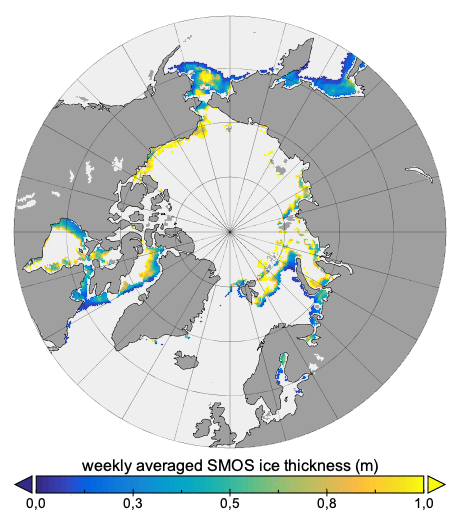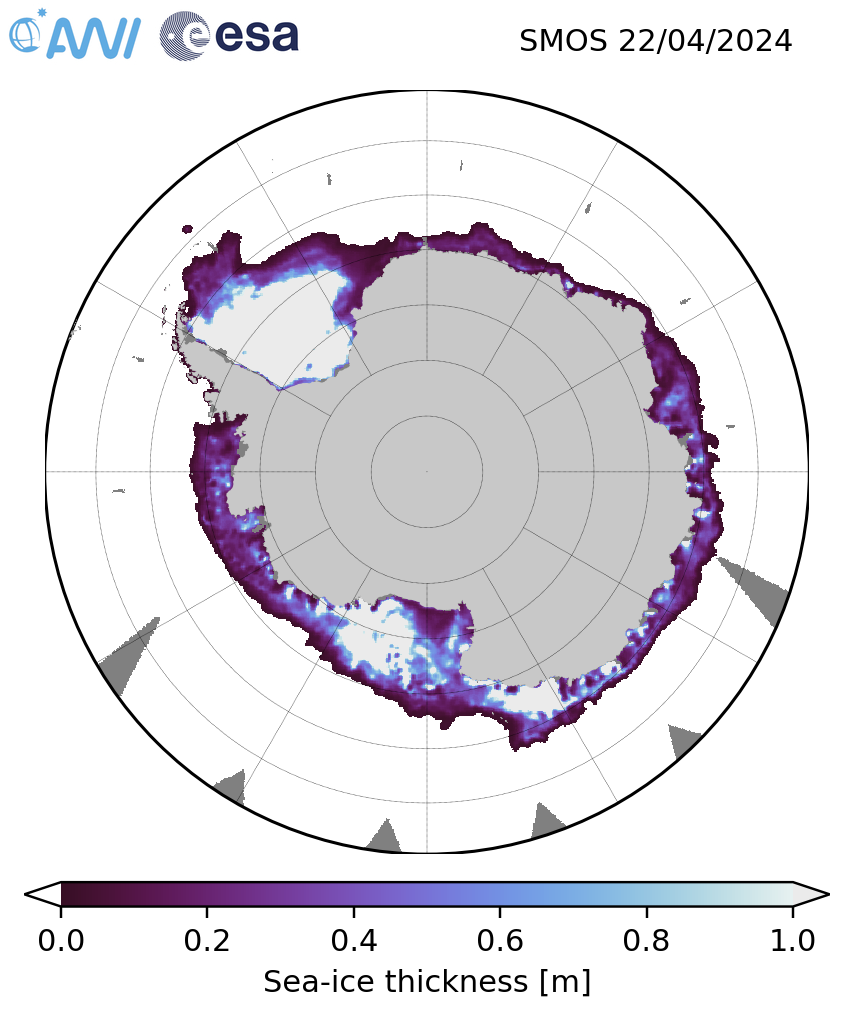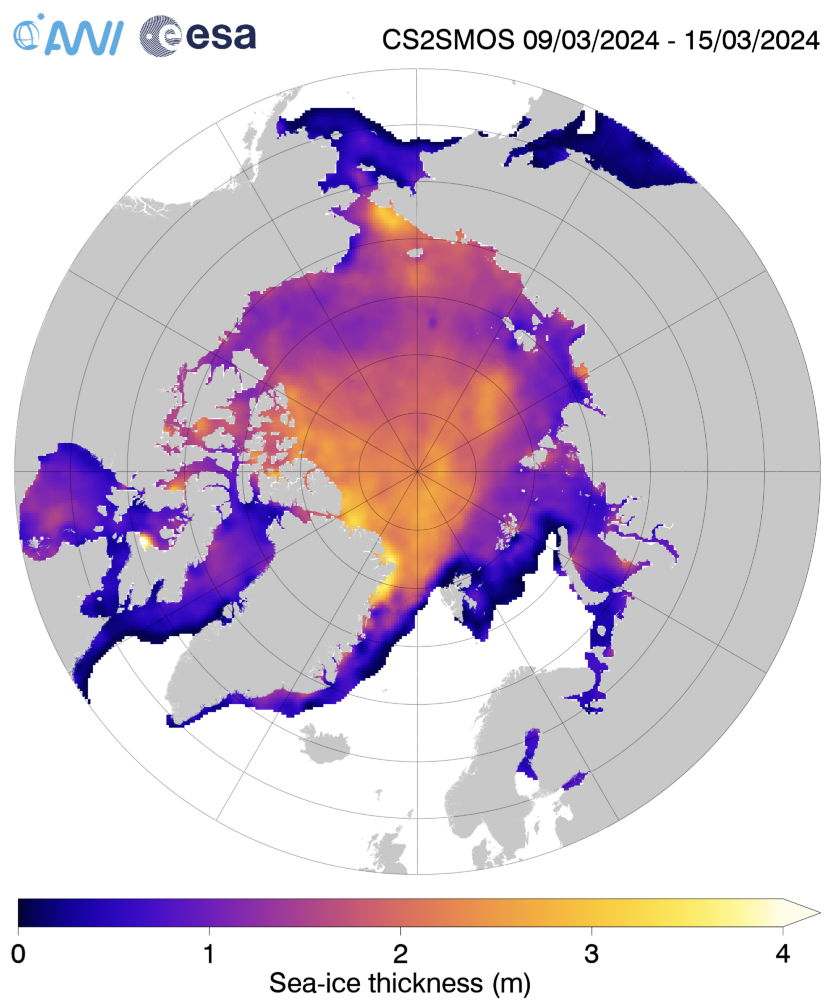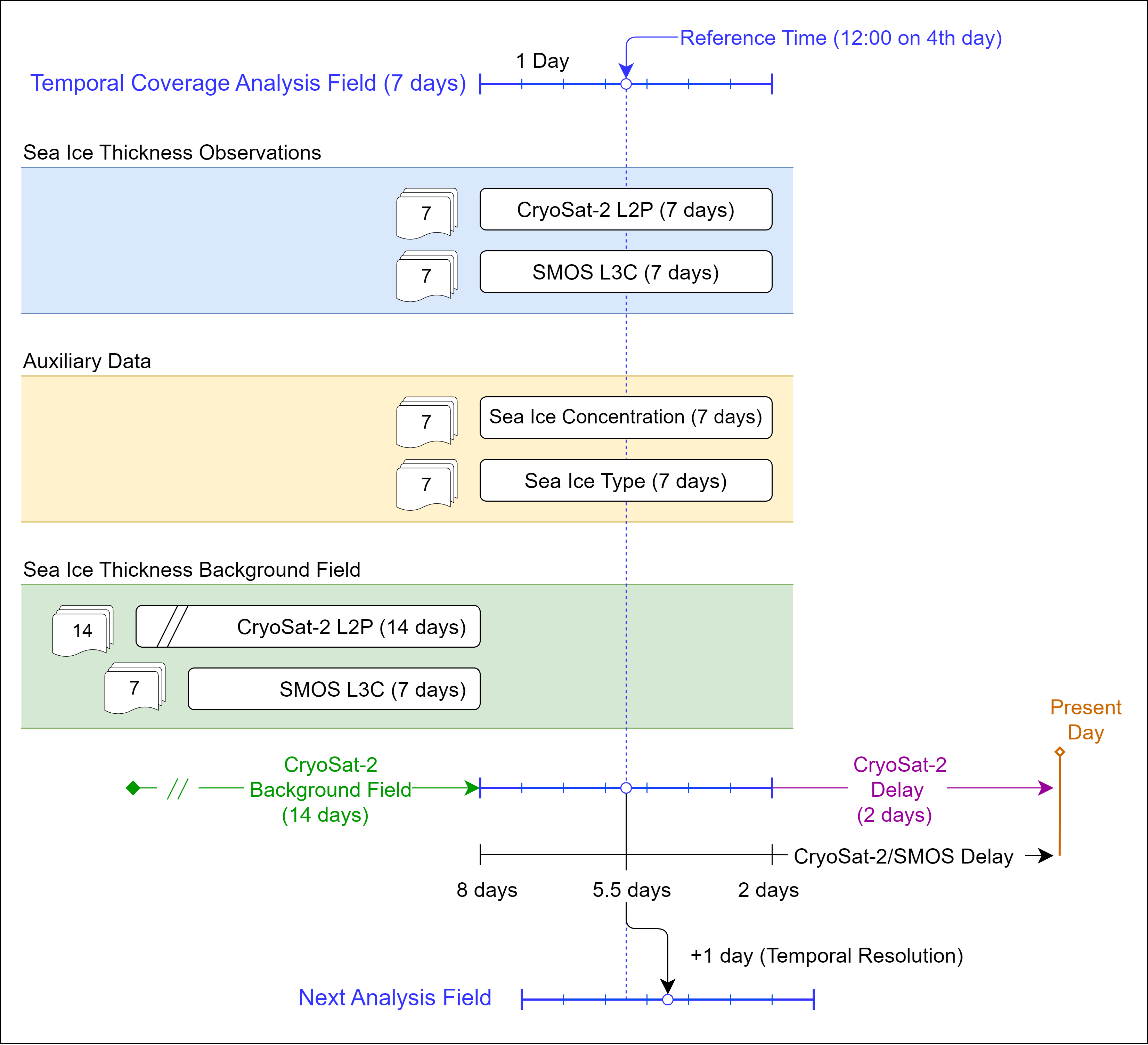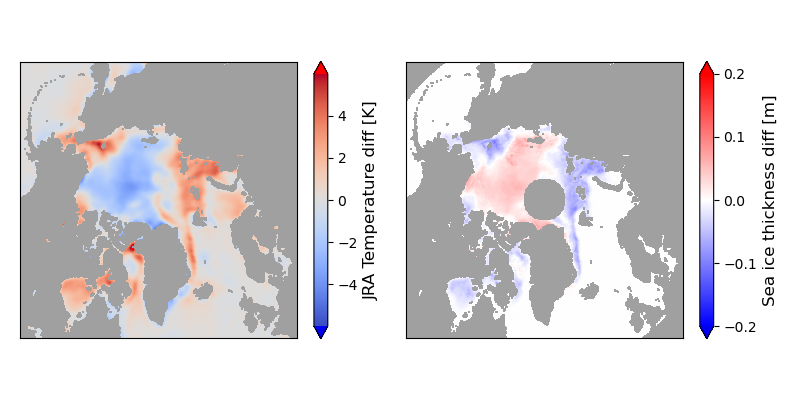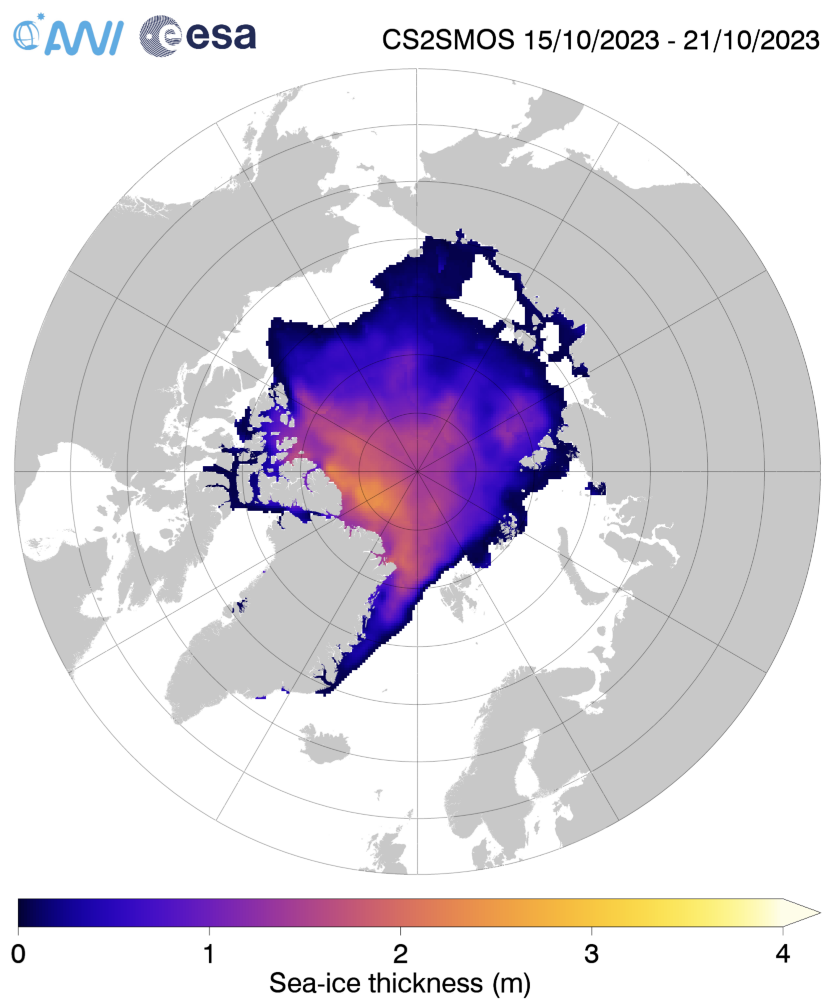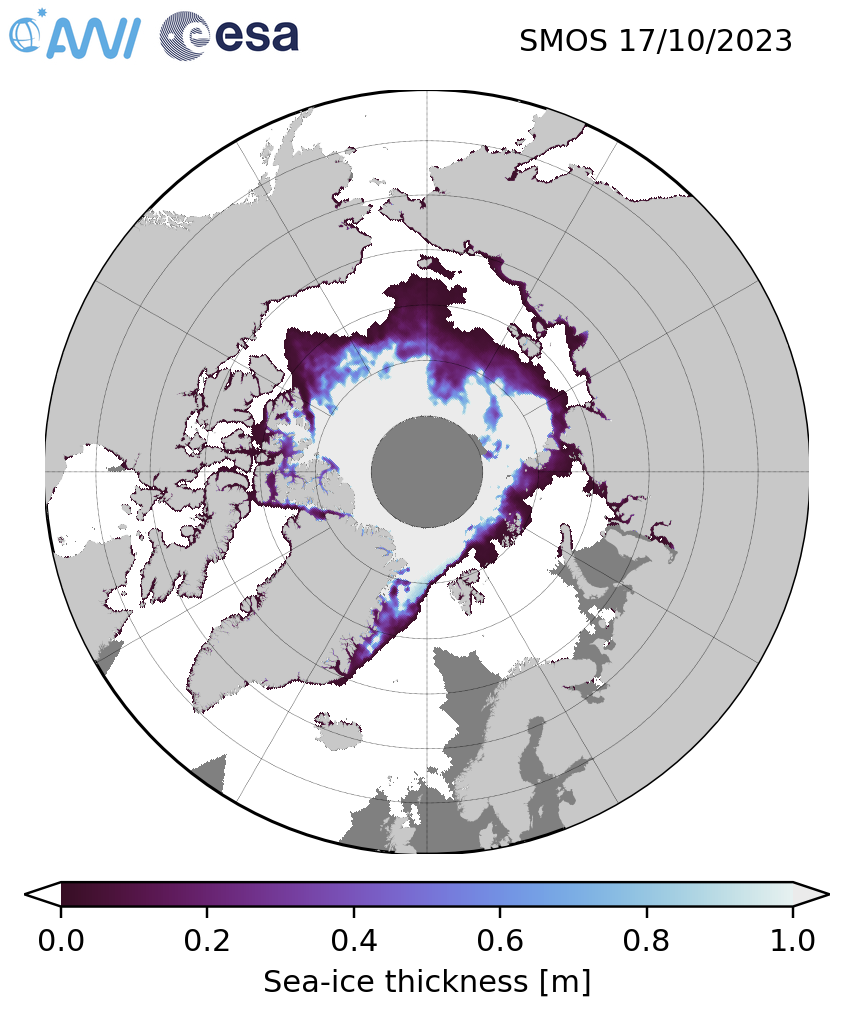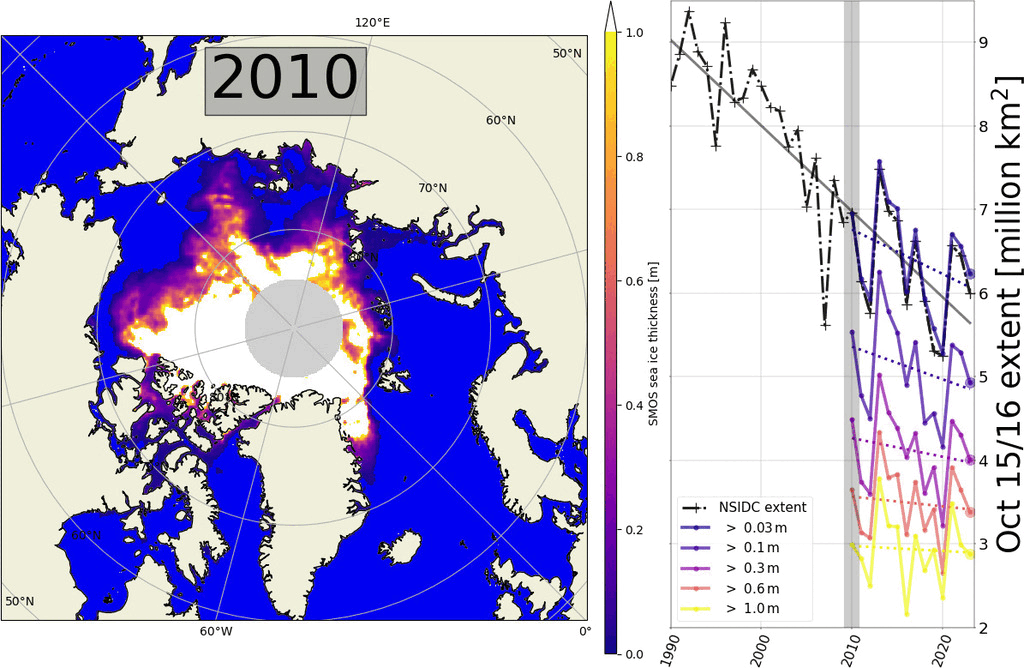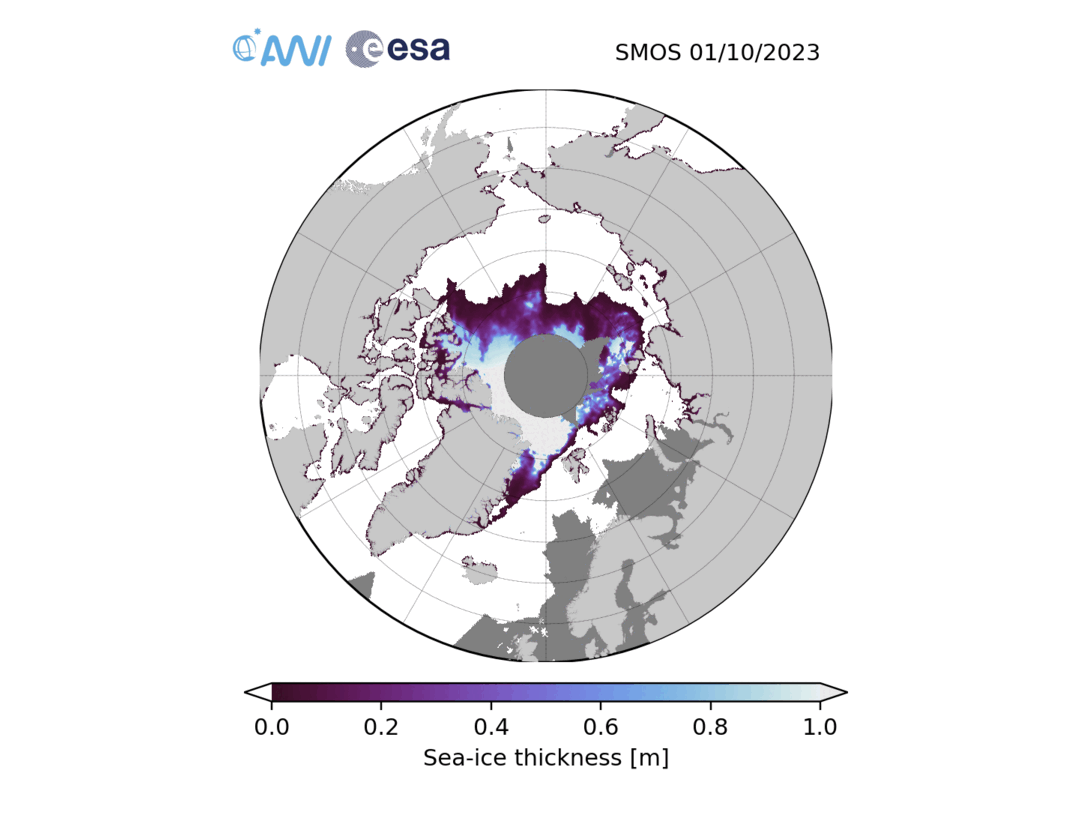Abstract
The SMOS & CryoSat-2 Sea Ice Data Product Processing and Dissemination Service (CS2SMOS-PDS) ensures the automated and continuous operational generation of the SMOS and the merged CryoSat-2/SMOS Sea Ice Thickness products.
Documentation
Data Access
Daily SMOS and weekly merged CryoSat-2/SMOS sea ice thickness data can be downloaded via FTP through a Web browser, a FTP client (e.g. FileZilla) or command line. The access is anomymous.
Info
How to cite the Data
For the merged CryoSat-2/SMOS sea ice thickness data, please
cite:
Ricker, R., Hendricks, S., Kaleschke, L., Tian-Kunze, X., King, J., and Haas, C.: A weekly Arctic sea-ice thickness data record from merged CryoSat-2 and SMOS satellite data, The Cryosphere, 11, 1607-1623, https://doi.org/10.5194/tc-11-1607-2017, 2017.
include the following phrase into the acknowledgment:
"The production of the merged CryoSat-SMOS sea ice thickness data was funded by the ESA project SMOS & CryoSat-2 Sea Ice Data Product Processing and Dissemination Service, and data from DATE to DATE were obtained from AWI."
For the SMOS Sea Ice Thickness data, please
cite:
Kaleschke, L., X. Tian‐Kunze, N. Maaß, M. Mäkynen, and M. Drusch (2012), Sea ice thickness retrieval from SMOS brightness temperatures during the Arctic freeze‐up period, Geophys. Res. Lett., 39, L05501, doi: 10.1029/2012GL050916.
include the following phrase into the acknowledgment:
"The production of the SMOS sea ice thickness data was funded by the ESA project SMOS & CryoSat-2 Sea Ice Data Product Processing and Dissemination Service, and data from DATE to DATE were obtained from AWI."
Merged CryoSat-2/SMOS Sea Ice Thickness Sample from 31 Jan 2011 – 06 Feb 2011
Blog
Operational processing and dissemination of near-real time L4 SMOS sea ice thickness product (v206) has been resumed for the winter season of 2024/25 since 15 October 2024.
A new version v300 will soon be offered in parallel to v206 for a transitional period. Watch this space for updates.
Changes of Note for version 300
- Addition of radar altimeter data from Sentinel-3A (since 2016-10) and Sentinel-3B (since 2018-10)
- Update to new SMOS sea ice thickness version 3.4
- Improved spatial resolution (12.5 km instead of 25 km)
- The Level-4 product will be generated for the southern hemisphere between mid-April and mid-October
Operational processing and dissemination of L3 SMOS sea ice thickness product (v3.3) has been resumed for the winter season of 2024/25 since 15 October 2024.
A new version v3.4 will soon be offered in parallel for a transitional period. Watch this space.
Operational processing and dissemination of L3 and L4 sea ice thickness products in the Arctic for the 2023/24 winter season ended on 15 April, 2024. Reprocessing of L4 CS2SMOS product (r product) will continue until end of May. Operational L3 SMOS data for the southern hemisphere is now available from 15 April, 2024 on for the austral winter season.
The v3.3 L3 SMOS data from 2010 to 2023 for the southern hemisphere is available under ftps://ftp.awi.de and ESA server:
The production of L4 CryoSat-2/SMOS sea ice thickness data has been resumed on after enough SMOS data became available for the optimal interpolation data requirements.
The data gap currently includes data from 16 days:
| Last file before the gap | W_XX-ESA,SMOS_CS2,NH_25KM_EASE2_20240221_20240227_o_v206_01_l4sit.nc |
|---|---|
| First file after the gap | W_XX-ESA,SMOS_CS2,NH_25KM_EASE2_20240309_20240315_o_v206_01_l4sit.nc |
While L3C SMOS sea ice thickness processing has been resumed., the generation of L4 CryoSat-2/SMOS will remain paused for a few more days, pending potential reprocessing of further missing days of SMOS L3C data.
The reason for this is the size of the current SMOS data gap between February 22 and March 7, 2024 (15 days). The L4 CryoSat-2/SMOS near real-time algorithm requires at least one SMOS file in the observations field (7 day period) and in background field (7 days before the observation field). With the 15 day gap either the observation field or the background field are empty and preventing a successful completion of the L4 CryoSat-2/SMOS near real-time data generation.
The situation will change in a few days, or when additional SMOS data in early March is made available.
Since 12 March we receive SMOS L1C data again and the L3C sea ice thickness processing has been resumed. Data from 8 to 11 March are reprocessed. Reprocessing of further missing days between 22 February and 7 March is not certain yet, which depends on the availability of SMOS L1C data.
Generation of the operational (near real-time) L4 CryoSat-2/SMOS product will be temporarily discontinued from March 1st 2024 onwards due to the Interruption of SMOS L3C data processing. Production will be resumed as soon as SMOS data is available again. Updated will be posted here.
The reprocessed L4 CryoSat-2/SMOS product is currently not affected.
SMOS L3C sea ice thickness processing has been interrupted since 22nd February. The reason is SMOS satellite switched to safe mode. Investigations are still in progress. The processing will be resumed as soon as the situation is normalised.
JRA55 reanalysis is an auxiliary data set for SMOS sea ice thickness retrieval. The update of this near real-time JRA55 data will terminate at the end of January 2024, instead, the Japanese Reanalysis for Three Quarters of a Century (JRA-3Q) will be used thereafter. The impact of this transition on L3 SMOS and L4 CS2SMOS products will be analyzed in detail after the reprocessing of the complete data in April 2024. A preliminary comparison of JRA55 and JRA-3Q temperature and its impact on L3 SMOS sea ice thickness product is shown in Figure 1. There is temperature difference up to 5K in some regions in the Arctic, which is caused by the update of sea-ice and snow schemes in JRA-3Q.
Figure 1. Temperature difference between JRA-3Q and JRA55 in December 2023 (left) and the difference in SMOS sea ice thickness caused by the transition from JRA55 to JRA-3Q for the same month (right).
Operational processing and dissemination of the L4 CryoSat-2/SMOS near real-time sea ice thickness product has been resumed for the winter season of 2023/24 with data since 15 October 2023. See CryoSat-SMOS Merged Sea Ice Thickness for updates of version 206.
The dissemination through ESA's Earth Online is running. The most recent data from October 17th show no major data gaps in the sea ice area. You can access data using the SMOS L3 catalogue tree view
Comparison of SMOS ice thickness extent with NSIDC sea ice index
An analysis of the first data from the Arctic freezing season shows that SMOS ice extent is lower than in the previous two years. The graph shows the SMOS ice extent for October 15 and 16, an average of two days. The data looks reasonable and is also consistent with the NSIDC sea ice extent.
Please note that missing data is filled with the average of all previous years. The gap filling was in particular necessary for the beginning of the time series for the 2010/2011 season with persistent RFI sources in the Greenland Sea (see Kaleschke and Tian-Kunze, 2021).
October 2023: RFI problems in Russian Arctic
The animation shows the SMOS sea ice thickness product in the first days of October. Data gaps (dark gray) occur primarily over the Russian parts of the Arctic Ocean. Such persistent RFI problems did not occur since the season 2010/2011.
Further analysis is required to evaluate whether it is possible to reduce data loss while maintaining data quality through improved (relaxed) RFI filtering techniques.
For more information on RFI see https://rfi.smos.eo.esa.int/
References
L. Kaleschke and X. Tian-Kunze, "SMOS Sea Ice Thickness Data Product Quality Control by Comparison with the Regional Sea Ice Extent," 2021 IEEE International Geoscience and Remote Sensing Symposium IGARSS, Brussels, Belgium, 2021, pp. 1110-1113, doi: 10.1109/IGARSS47720.2021.9553630.
Operational processing and dissemination of L3 SMOS sea ice thickness product has been resumed for the winter season of 2023/24 since 15 October 2023.
Operational processing and dissemination of L3 and L4 sea ice thickness products in the Arctic for the 2022/23 winter season ended on 15 April, 2023. Reprocessing of L4 CS2SMOS product (r product) will continue until end of May.
L3 SMOS Sea Ice Thickness data processing is resumed since 9 December. The missing L3 SMOS data have been reprocessed. From 12 December on the operational L4 CS2SMOS SIT product is no longer degraded.
